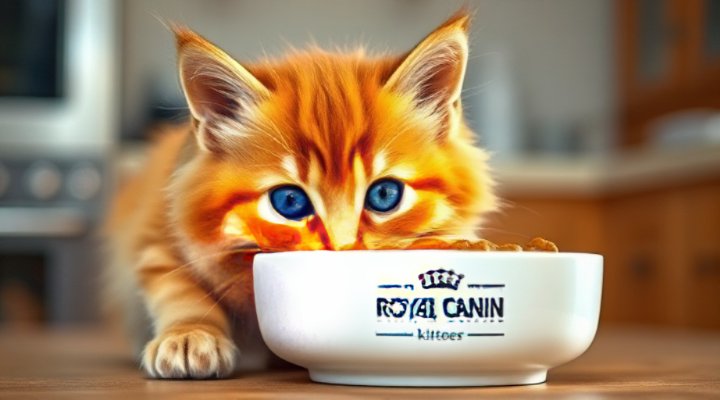Summary: This comprehensive Royal Canin kitten feeding guide provides essential nutritional information and practical feeding recommendations to support your kitten’s healthy development. We’ll explore the science behind Royal Canin’s specialized formulas, proper feeding techniques, and age-specific requirements to ensure your furry companion receives optimal nutrition during this critical growth phase.

Understanding Royal Canin Kitten Nutrition Science
Royal Canin has dedicated decades to researching feline nutrition, particularly focusing on the unique needs of growing kittens. Their approach combines scientific research with practical application, creating formulas that address specific developmental requirements. For instance, their kitten nutritional requirements are based on extensive studies of kitten growth patterns and digestive capabilities.
What makes Royal Canin kitten food particularly effective is its balanced nutrient profile. The formulas contain precisely calibrated levels of proteins, fats, carbohydrates, vitamins, and minerals that support optimal growth. Additionally, the inclusion of prebiotics and specific fiber blends promotes digestive health, which is crucial for kittens with sensitive systems. This scientific approach ensures that every kibble delivers complete and balanced nutrition tailored to your kitten’s developmental stage.
Key Nutritional Components in Royal Canin Kitten Food
Royal Canin formulations include several key components that set them apart. High-quality proteins support muscle development, while DHA from fish oil contributes to brain and vision development. The controlled mineral content supports bone growth without overloading the system, and antioxidant complexes including vitamins E and C help support the developing immune system. These carefully selected ingredients work synergistically to provide comprehensive nutritional support.

Royal Canin Kitten Product Range Overview
Royal Canin offers a diverse range of kitten products designed to meet various needs and preferences. Their Mother & Babycat formula is specifically created for weaning kittens and nursing mothers, featuring ultra-small kibble size that’s easy for tiny mouths to manage. The standard Kitten formula provides complete nutrition for kittens from 2-12 months, while specialized options address specific needs like digestive sensitivity.
When I first brought home my kitten Whiskers, I was overwhelmed by the product choices. However, understanding that Royal Canin designs each product for specific life stages and needs made the selection process much easier. For example, their wet food options provide hydration benefits and variety, while dry foods help maintain dental health. According to the American Veterinary Medical Association, combining wet and dry foods can provide both nutritional and dental benefits.
Choosing the Right Royal Canin Product for Your Kitten
Selecting the appropriate Royal Canin product depends on several factors including your kitten’s age, breed size, and any specific health considerations. Smaller breed kittens may benefit from formulas with higher energy density, while larger breeds might require controlled growth formulas. Always consult with your veterinarian to determine the best option for your particular kitten’s needs and consider any sensitive stomach considerations if applicable.
Establishing a Proper Royal Canin Kitten Feeding Schedule
Creating a consistent feeding schedule is crucial for your kitten’s digestive health and overall well-being. Young kittens (2-6 months) typically require more frequent meals—about 3-4 times daily—due to their small stomach capacity and high energy needs. As they grow older (6-12 months), you can gradually reduce feedings to 2-3 times daily. This structured approach helps regulate their metabolism and prevents overeating.
Portion control is equally important when following a Royal Canin kitten feeding guide. The packaging provides general guidelines based on weight and age, but individual needs may vary. I learned this lesson when Whiskers started leaving food in his bowl—it turned out I was serving slightly too much. Monitoring your kitten’s body condition and adjusting portions accordingly ensures they receive adequate nutrition without excessive weight gain.

Transitioning to Royal Canin Kitten Food
When introducing Royal Canin kitten food, a gradual transition over 7-10 days is recommended to avoid digestive upset. Start by mixing 25% new food with 75% current food for 2-3 days, then increase to 50/50 for another 2-3 days, followed by 75% new food for 2-3 days before switching completely. This method allows your kitten’s digestive system to adapt to the new formula gradually.
During the transition period, monitor your kitten for any signs of digestive discomfort such as loose stools or decreased appetite. If issues persist beyond a few days, consult your veterinarian. Remember that some kittens may be more sensitive to dietary changes than others, so patience and careful observation are key to a successful transition to Royal Canin nutrition.
Age-Specific Royal Canin Feeding Guidelines
Kitten nutritional needs change significantly during their first year, and Royal Canin provides specific guidance for each developmental stage. From 2-4 months, kittens experience rapid growth and require nutrient-dense food served in multiple small meals. Between 4-12 months, growth continues but at a slower pace, requiring adjusted portion sizes to maintain ideal body condition.
The FDA’s pet food labeling guidelines help ensure you understand exactly what you’re feeding your kitten. Royal Canin clearly labels their products with age recommendations and feeding guidelines, making it easier to provide appropriate nutrition at each stage. Regular weight checks and body condition assessments will help you adjust portions as your kitten grows and develops.
Monitoring Your Kitten’s Growth and Development
Regular monitoring ensures your Royal Canin feeding regimen supports healthy development. Look for consistent weight gain without excessive fat accumulation, shiny coat, clear eyes, and good energy levels. If you notice any concerns such as poor weight gain, digestive issues, or lethargy, consult your veterinarian promptly. These could indicate the need for dietary adjustments or medical attention.
Common Feeding Challenges and Solutions
Many kitten owners encounter feeding challenges, but most can be resolved with patience and proper techniques. Picky eaters may benefit from mixing wet and dry food or slightly warming the food to enhance aroma. For kittens that eat too quickly, puzzle feeders or slow-feed bowls can help pace their consumption and improve digestion.
Digestive sensitivity is another common issue that Royal Canin addresses through specialized formulas. If your kitten experiences frequent digestive upset, consider their sensitive stomach options or consult your veterinarian about potential food allergies or intolerances. Sometimes, simple adjustments like smaller, more frequent meals can make a significant difference in digestive comfort.

Integrating Royal Canin with Overall Kitten Care
Proper nutrition is just one component of your kitten’s overall health regimen. Regular veterinary check-ups, appropriate vaccination schedules, and proper socialization all contribute to your kitten’s well-being. Additionally, dental health considerations should be part of your overall care plan, as dental issues can affect nutrition and overall health.
Remember that every kitten is unique, and what works perfectly for one may need adjustment for another. The beauty of Royal Canin’s approach is their commitment to scientific research and quality control, providing consistent nutrition that you can trust. By combining their expert formulations with your attentive care and regular veterinary guidance, you’re giving your kitten the best possible start in life.
Long-Term Nutritional Planning
As your kitten approaches adulthood, planning the transition to adult food becomes important. Royal Canin recommends switching to adult formulas around 12 months of age, though larger breeds may benefit from extended kitten formula feeding. The transition should follow the same gradual process as initial introduction, allowing your cat’s system to adapt to the new nutritional profile.
Related Keywords: royal canin kitten nutrition, kitten feeding schedule, royal canin babycat milk, kitten growth development, royal canin portion control, kitten digestive health, royal canin product selection, kitten weaning process, royal canin nutritional science, kitten dietary requirements

